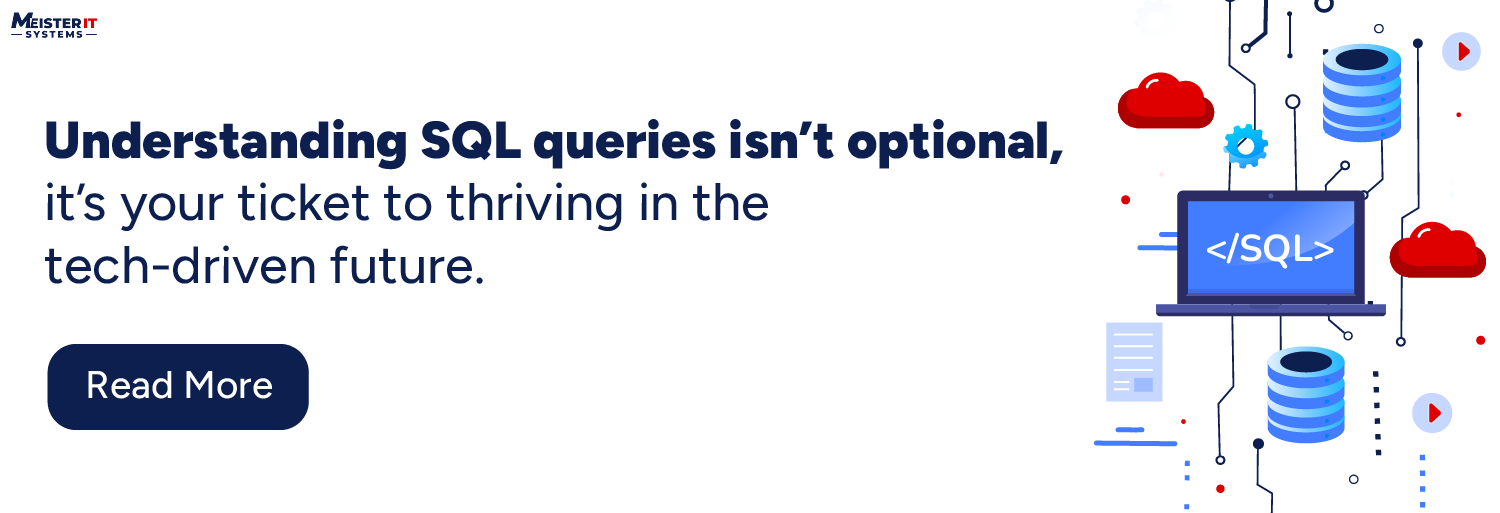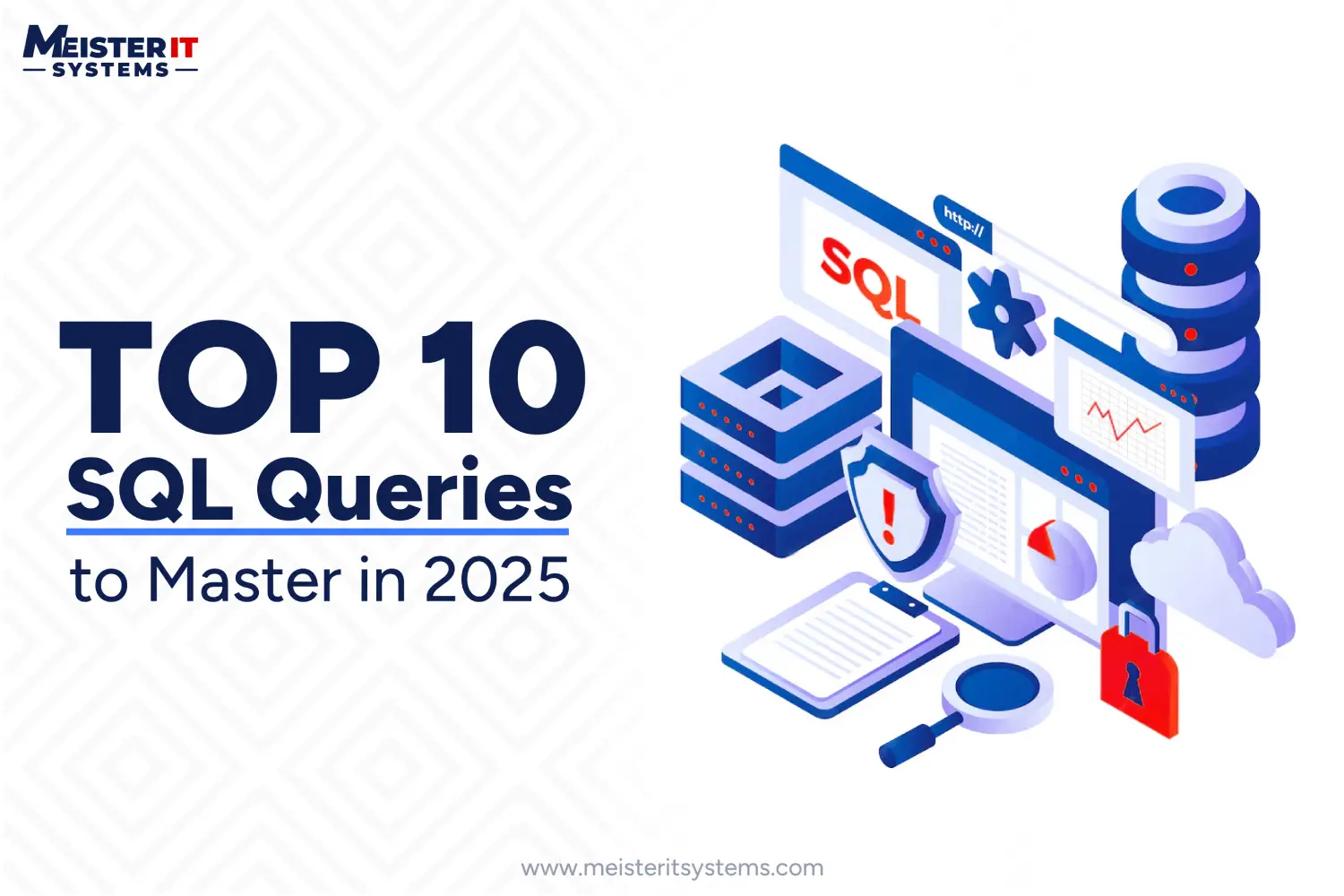Introduction
For decades, SQL has been at the core of data management, empowering businesses to make informed, data-driven decisions. Whether it’s organising complex datasets, supporting real-time analytics, or optimising database performance, SQL remains at the heart of modern business operations.
As we move closer to 2025, the demand for SQL expertise is only increasing. With advanced capabilities like handling complex data processing and powering AI-driven models, SQL has transcended its role as a database language—it’s now a key enabler of cutting-edge technologies.
At MeisterIT Systems, we understand the importance of staying ahead. That’s why we’ve curated a comprehensive blog featuring the top 10 SQL queries to master for 2025.
This guide will help you sharpen your skills, whether you’re just starting or refining your expertise.

Understanding SQL Queries
SQL, or Structured Query Language, isn’t just a tool—it’s the lifeline of modern data management.
Since its creation in the 1970s by IBM researchers, SQL has set the universal standard for managing relational databases, transforming how industries harness the power of data to drive smarter decisions.
What Are SQL Queries?
SQL queries are commands that communicate with databases, enabling you to:
- Retrieve specific information from massive datasets.
- Update and manipulate data in real-time.
- Automate processes to save time and improve efficiency.
These queries act as the bridge between raw data and actionable insights, making them indispensable in a data-driven world.
Why SQL Queries Matter?
SQL isn’t just about retrieving data—it’s about using that data to solve real-world problems. Here’s how it drives impact:
- Simplify complex data management: Organise, sort, and connect data points effortlessly.
- Boost database performance: Optimise processes for faster, more reliable operations.
- Integrate with modern technologies: Power AI models, real-time analytics, and more.
SQL in today’s technology landscape
SQL isn’t limited to databases anymore. It’s a foundational skill that complements programming languages like Python and Java, allowing developers to create scalable and efficient systems.
The future of SQL Queries
As we approach 2025, the relevance of SQL is skyrocketing. From advanced data processing to driving machine learning algorithms, SQL queries are at the core of technological innovation. Professionals who master SQL will be well-positioned to lead in the data-centric era.
The bottom line?

Mastering Top SQL Queries in 2025
Want to stand out in the data-driven world of 2025?
It all starts with mastering the right SQL queries.
In this section, we’ll spotlight the 10 most essential SQL queries you should master for 2025. Whether it’s refining your skills with SELECT, unlocking the power of JOIN, or grouping data with GROUP BY, these queries will be the foundation of your expertise in an increasingly data-centric future.
So, let's dive deep into it.
1. SELECT Query: The Core of SQL
The SELECT statement is the foundation of SQL, used to fetch data from a database. Despite its simplicity, mastering its complexities is essential.
FROM employees
WHERE department = 'Sales';

Explanation: This simple query demonstrates how to filter records using the SELECT statement and a WHERE clause. By mastering SELECT, you can extract data in a variety of formats, including filtering, sorting, and grouping results.
2. JOIN Queries: Connecting Data
JOIN statements retrieve data from multiple tables. Understanding the various types of JOINs (INNER, LEFT, RIGHT, and FULL) is critical when working with relational databases.
FROM employees
INNER JOIN departments ON employees.department_id = departments.department_id;

Explanation: In this query, we use an INNER JOIN to connect the employees and departments tables via a common field (department_id). Employees' first and last names, as well as their department names, are included in the results. Mastering JOINs will allow you to effectively combine data from multiple tables and create meaningful reports.
3. GROUP BY and Aggregation Queries
The GROUP BY statement allows you to group rows with the same values in specified columns and apply aggregate functions like SUM, AVG, or COUNT.
FROM employees
GROUP BY department_name;

Explanation: This query returns the total number of employees in each department. The GROUP BY clause groups the data by department, and COUNT is used to calculate the total number of employees in each group.
Businesses will rely more on aggregation for reporting and analytics by 2025, making this a necessary skill.
4. Subqueries and Nested Queries
A subquery is a query within another query, often used to fetch intermediate results or filter data.
FROM employees WHERE department_id = (SELECT department_id FROM departments WHERE department_name = 'Sales');

Explanation: This query uses a subquery to first determine the department_id for the Sales department, and then the outer query retrieves the names of employees in that department. Subqueries are an elegant solution for breaking down complex problems into smaller, manageable queries.
5. Window Functions: Analysing Data Without Aggregation
Window functions allow you to perform calculations across a set of table rows related to the current row without collapsing them into a single output row like an aggregate function would.
FROM employees;

Explanation: We use the RANK() function to rank employees based on their salaries without grouping the data. Each employee's rank is shown alongside their salary. Window functions are ideal for performing analytics directly in the database, which is becoming increasingly important in real-time reporting.
6. CTE (Common Table Expressions) and Recursive Queries
CTE is a temporary result set defined within a SQL query that can be referenced multiple times. Recursive queries are useful for hierarchical data.
SELECT department_id, department_name
FROM departments
)
SELECT department_name, COUNT(*)
FROM employees
INNER JOIN DepartmentCTE
ON employees.department_id = DepartmentCTE.department_id
GROUP BY department_name;

Explanation: In this example, the CTE DepartmentCTE simplifies the query by saving the result of a SELECT statement for later use. This makes SQL cleaner and easier to maintain, particularly for complex queries.
7. INSERT, UPDATE, DELETE: Managing Data Efficiently
Understanding how to manipulate data using INSERT, UPDATE, and DELETE queries is crucial for maintaining a database.
VALUES ('John', 'Doe', 2, '2024-01-15');

SET salary = 70000
WHERE employee_id = 101;

WHERE employee_id = 105;

Explanation: These commands allow you to modify data within your tables. For example, INSERT adds new data, UPDATE modifies existing data, and DELETE removes data. Effectively handling these commands ensures that your database is up to date and accurate.
8. Advanced Filtering with WHERE, HAVING, and CASE Statements
Advanced filtering techniques make your queries more powerful by introducing conditional logic.
CASE
WHEN salary > 80000 THEN 'High'
WHEN salary BETWEEN 50000 AND 80000 THEN 'Medium'
ELSE 'Low'
END AS salary_range
FROM employees;

Explanation: Here, the CASE statement categorises employees based on their salary. Using WHERE and HAVING refines your filtering, allowing you to target specific rows in simple and complex queries.
9. Optimising SQL Queries: Indexing and Performance Tuning
Optimising SQL queries is critical as databases grow in size. Using indexes can drastically speed up data retrieval.
ON employees (last_name);

Explanation: This query creates an index for the employees table's last_name column. Indexes improve search performance by reducing the amount of data scanned during a query. By 2025, large-scale databases will require fine-tuned performance, making optimisation an essential skill.
10. JSON and XML Queries in SQL
Handling JSON and XML data in SQL has become increasingly important with the rise of unstructured data in modern applications.
JSON_VALUE(personal_info, '$.address.city') AS city
FROM employees;

Explanation: We use this query to extract the city field from a JSON object stored in the personal_info column. As more data is stored in formats such as JSON and XML, knowing how to query it directly in SQL will be an essential skill in 2025.
Conclusion
As we move toward 2025, mastering SQL will be essential for professionals looking to excel in the field of data management. Becoming proficient in key queries—from basic SELECT statements to advanced techniques like window functions and JSON handling—will not only elevate your technical expertise but also provide a significant advantage in a highly competitive, data-driven job market.
Also, partnering with MeisterIT Systems means gaining access to expert SQL services that will help you develop and optimise projects to fully leverage your data. If you need assistance with your SQL project, our team of skilled SQL developers is here to design and implement tailored data management solutions, streamline operations, and drive smarter, more efficient business outcomes.
Take your projects to the next level—partner with us today to stay ahead of the curve and maximise the impact of your data-driven strategies.
Frequently Asked Questions
FAQ 1: What is the most important SQL query to learn in 2025?
The JOIN operation is the most important SQL query to learn by 2025. Mastering JOINs is critical for retrieving data from multiple tables and performing complex queries involving relationships between datasets. This skill is foundational for data analysis and reporting.
FAQ 2: How can I improve the performance of my SQL queries?
To improve SQL query performance, consider techniques like indexing, optimise joins, limit data retrieval, and query plan analysis.
FAQ 3: What are the best resources to practice SQL queries?
The best resources to practice SQL queries include:
- LeetCode offers a variety of SQL problems for hands-on practice.
- HackerRank provides a platform for coding challenges, including SQL exercises.
- SQLZoo is an interactive site with tutorials and practice problems.
- Mode Analytics SQL Tutorial will guide with exercises and real-world scenarios.
- W3Schools SQL Tutorial is a beginner-friendly resource with explanations and practice opportunities.
